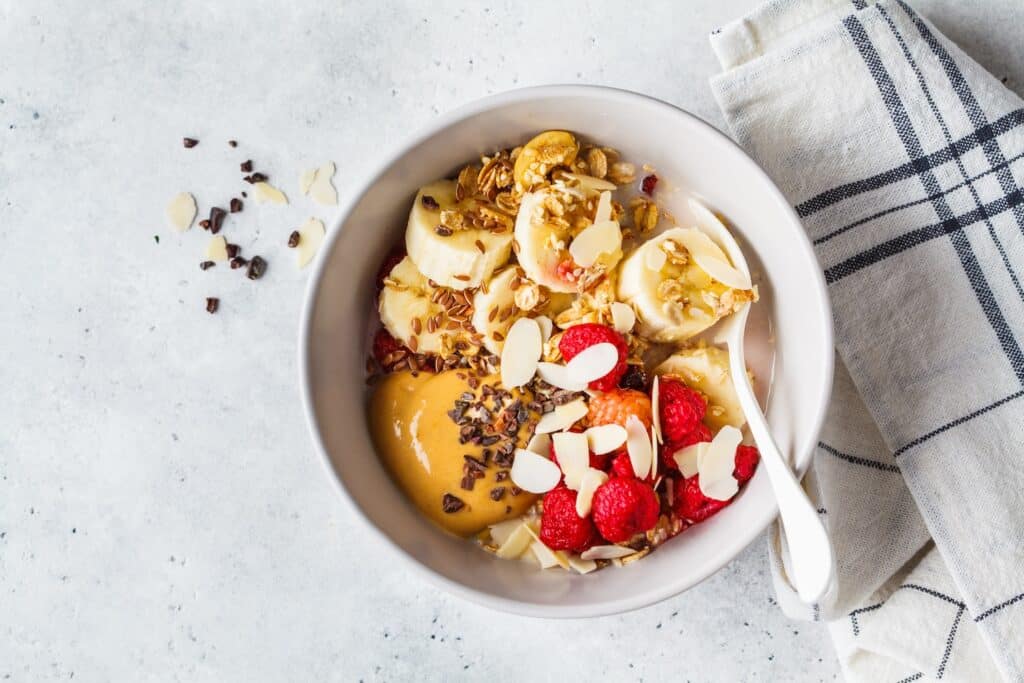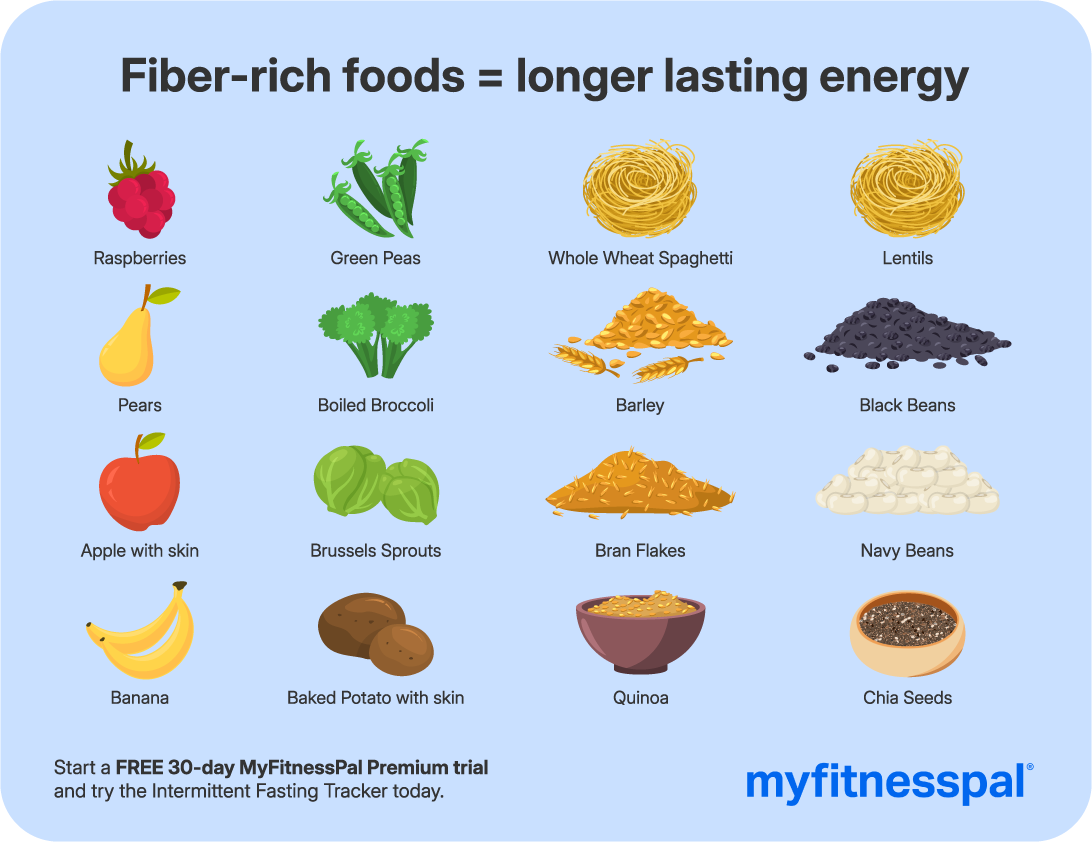
If you’ve ever felt bloated, sluggish, or constantly hungry despite eating regular meals, you may have experienced some of the symptoms of low fiber.
And you’re not alone. More than 90% of Americans might not be getting the recommended amount of fiber. That’s 25 grams of fiber per day for women and 38 grams for men (1).
In fact, according to a survey conducted by MyFitnessPal, 88% of members surveyed say they have no idea how much fiber, protein, carbs, sugar, or salt they consume daily. Only 52% of people surveyed pay attention to how much fiber they’re consuming every day.
Ready to focus on fiber and reap the benefits? We’re here to help you spot the signs of low fiber intake—and how to fix it.
Risks of Not Getting Enough Fiber
Knowing what can go wrong when you don’t eat enough fiber can help motivate you to make it a priority. A low-fiber diet doesn’t just mess with your digestion—it can lead to more serious health problems over time, including (3):
- Increased risk of heart disease
- Blood sugar fluctuations
- Difficulty maintaining a healthy weight
- Increased risk of colon cancer
Symptoms of a Low-Fiber Lifestyle
Sometimes your symptoms are subtle, like a vague sense of fatigue and sometimes they’re more obvious, like constipation, and you just didn’t connect them to your diet.
Here are some of the most telling signs that your fiber intake could use a boost:
Constipation
Fiber adds bulk to your stool and helps everything move smoothly through your intestines. Without enough fiber, stool can become hard, dry, and more difficult to pass, leading to uncomfortable and infrequent bowel movements.
And when constipation is a way of life thanks to a low-fiber diet, it can cause bloating, stomach discomfort, and even hemorrhoids due to straining while using the bathroom.
Fiber, especially soluble fiber in foods like oats and beans, can ease this problem. It helps pull water into the intestines and soften stool. Insoluble fiber from whole grains and certain vegetables helps, too. It acts like a broom sweeping through your system to keep things moving (4).

You might also like
Are You Eating Enough Fiber? Get Your Fiber Score
Weight Loss Feels Hard
If you’re eating in a calorie deficit but still struggling to lose weight, fiber might be the missing ingredient in your diet. High-fiber foods take longer to digest, which helps prevent hunger too soon after eating. (1).
Fiber also helps keep your blood sugar on an even keel. This means you’ll have fewer cravings for quick fixes like sugary snacks (6). Research shows that people who eat more fiber naturally consume fewer calories throughout the day by up to 10% (7).
So, if weight loss is your goal, swapping refined carbs for fiber-rich whole grains, legumes, and vegetables might make a big difference in how satisfied you feel.
About the Experts
Caroline Thomason, RD, is a dietitian and diabetes educator combining her love of nutrition with the power of making better health easy to understand. With 12 years in the industry, her work has appeared in more than 40 publications. She’s also a speaker, broadcast spokesperson, and recipe developer.
Joanna Gregg, MS, RD, is a Food Data Curator at MyFitnessPal. She earned her Master’s degree from The University of Nebraska. Her focus is helping people find the right balance of food, fitness and healthy living to reach their optimal health.
Katherine Basbaum, MS, RD, is Food Data Curator at MyFitnessPal. She received her Masters in Nutrition Communication from the Friedman School of Nutrition Science & Policy at Tufts University and completed her Dietetic Internship at UVA Health, where she also works as a nutrition counselor for cardiology patients.
Lack of Energy
You know those blood sugar crashes that send you to the vending machine at 3pm? Well, they also affect your energy levels throughout the day.
Without enough fiber to slow digestion, carbohydrates may be more quickly broken down into sugar, causing a burst of energy followed by the sudden urge to nap (6).
If you often feel blah after meals or struggle with brain fog, try boosting your fiber intake.
Swap refined carbs for whole grains, add a serving of vegetables to your meals, or snack on some nuts and a piece of fruit to provide the steady release of energy your body needs to keep you going steady.
Irregular Bowel Movements
Constipation isn’t the only digestive symptom of a low fiber diet. You also may find that you have unpredictable or irregular bathroom habits.
Since fiber helps regulate your digestion, a low fiber diet can leave your digestive system feeling bloated, uncomfortable, or just unpredictable (8). No matter which side of the spectrum your gut tends to lean, fiber will likely help you regulate it.

You might also like
An Essential Guide to Daily Fiber Requirements
Irritable Bowel Syndrome (IBS) Flare Ups
Irritable bowel syndrome, or IBS, is a common condition that can leave you experiencing diarrhea, constipation, or a combination of the two. One in 20 people in the US is living with IBS (9).
If you’re one of them, fiber can play a key role in managing your IBS symptoms. Too little fiber in your diet could worsen constipation, and increase symptoms of bloating, gas, or cramping (9).
On the other hand, focusing on eating enough fiber could improve constipation, slow down diarrhea, or generally help regulate your gut depending on your irregular symptoms (4, 8).
Specifically, soluble fiber is more gentle on the gut than insoluble fiber (9). High soluble fiber vegetables like sweet potatoes, and carrots may be foods to start with for a gentle increase in your fiber intake (10).
Keep in mind that increasing your fiber intake too quickly or increasing your insoluble fiber from foods like raw green vegetables can worsen IBS symptoms for some (11). Talk with your healthcare provider about the best fiber strategy for you if you know you have IBS.
FIBER & IBS: What to Eat & Avoid
| Foods to Include (Generally Well-tolerated) | Foods to Avoid (May Trigger Symptoms) |
| Oats (rolled or steel-cut) | Wheat bran cereals |
| Chia seeds (in water or smoothies) | Whole nuts and seeds |
| Psyllium husk (Metamucil, fiber supplements) | Corn (limit to 1/2 cob or 1/2 cup) |
| Ripe bananas | Cabbage (limit to 3/4 cups) |
| Peeled and cooked carrots | Brussels sprouts |
| Peeled zucchini (cooked) | Onions and garlic |
| Potatoes without skin | Apples and pears with skin |
| White rice | Whole wheat bread and pasta |
| Canned, well-rinsed lentils (limit to 1/4 to 1/2 cup) | Beans (especially undercooked) |
| Sourdough or spelt bread (low FODMAP options) | Canned or unrinsed lentils |
How to Get Enough Fiber
If you’re struggling to get your daily fiber goal, you might be considering a fiber supplement. Those can sometimes have a place, but in general it’s a better idea to get your fiber from whole foods according to Katherine Basbaum, a MyFitnessPal dietitian. “In addition to the fiber, whole foods give you a bunch of other healthy nutrients, vitamins and minerals,” she says.
Here are some dietitian-approved ways to increase your fiber intake:
Eat More Plant Foods
One of the simplest strategies for increasing your fiber intake is to prioritize plants!
You don’t have to eat a plant-based diet or go vegan or vegetarian to reap the benefits of plants in your diet.
All these whole foods are fiber all-stars:
- Whole grains
- Fruits
- Vegetables
- Beans
- Nuts
- Seeds
Pro tip: When it comes to fiber, don’t overlook seeds! Joanna Gregg, another MyFitnessPal dietitian, especially likes flaxseeds.

Start Your Day with Fiber
Breakfast can set the tone for your day. Starting with a high-fiber meal can help keep you full and energized all morning. If you typically eat a low fiber breakfast, adding something can go a long way to boosting your fiber intake.
Try adding any of these to boost the fiber in your morning meals:
- Whole-grain toast
- Berry smoothie
- Chia seeds
- Avocado
- Apple
- Banana
- Oatmeal
Snack Smart
Instead of reaching for chips or crackers, which rarely give you much fiber, choose nuts, seeds, raw veggies, or hummus instead for a snack. As a dietitian, I tell people to shoot for at least 3 to 5 grams of fiber per snack! This could look like a piece of whole-grain toast, peanut butter, and banana sliced on top or it could be Greek yogurt with berries and chia seeds.
Start Small
Boosting your fiber intake doesn’t have to mean completely overhauling your diet. Simple, small swaps can add up to large results.
Here are a few ideas:
- Choose whole-grain bread at the store instead of white
- Add some beans to your soup or salad
- Snack on hummus or bean dip
These small choices add up to a big increase in your fiber intake.
How to Know You’re Eating Enough Fiber
Not sure if you’re hitting your fiber goals? You’re not alone—most people don’t track their fiber intake, which means they might not realize they’re coming up short.
Your body has ways of letting you know! If you’re dealing with any of the symptoms outlined above, like sluggish digestion, feeling hungry soon after meals, or experiencing those dreaded energy crashes, your diet might be lacking this essential nutrient. The good news is it’s easy to keep tabs on your fiber intake.
MyFitnessPal makes it simple by tracking your daily and weekly fiber totals, so you can spot patterns and make small adjustments where needed. Once you start paying attention, you’ll quickly see where you can level up your fiber game.
Download the app and start tracking your fiber today!
The post 5 Signs You’re Not Eating Enough Fiber appeared first on MyFitnessPal Blog.

